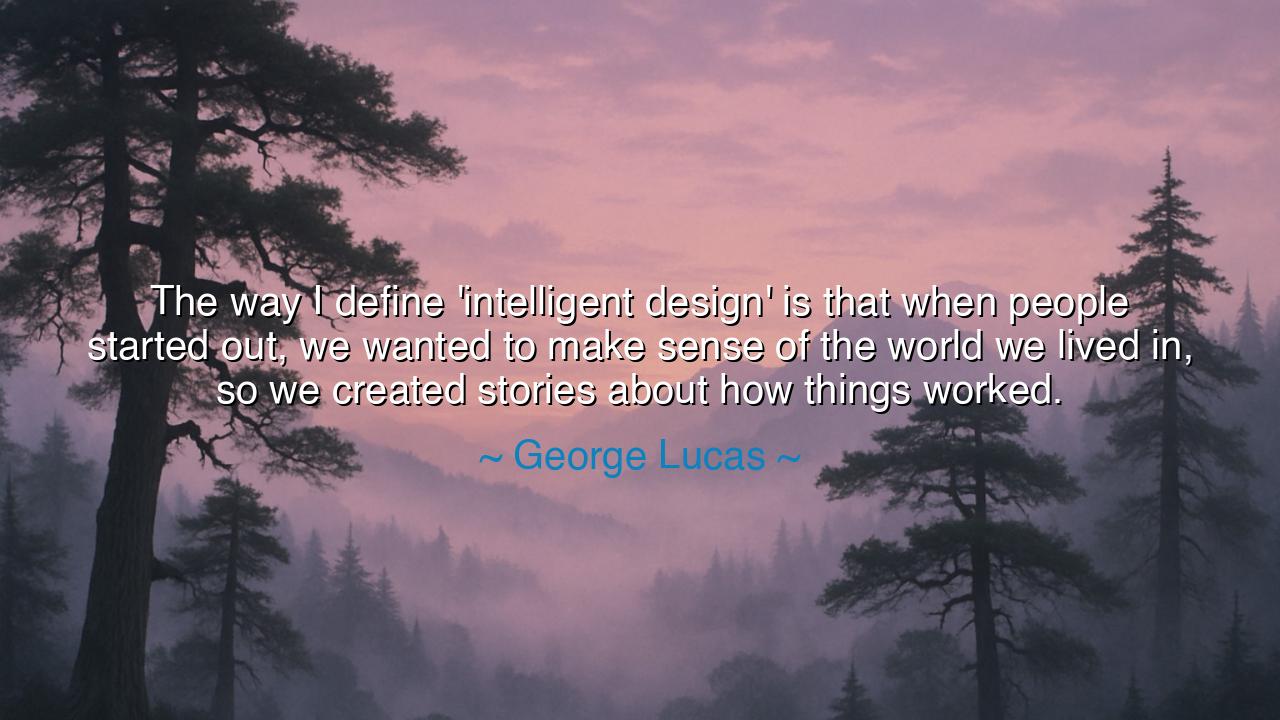
The way I define 'intelligent design' is that when people started
The way I define 'intelligent design' is that when people started out, we wanted to make sense of the world we lived in, so we created stories about how things worked.






“The way I define ‘intelligent design’ is that when people started out, we wanted to make sense of the world we lived in, so we created stories about how things worked.” – George Lucas
Listen well, seekers of meaning and dreamers of worlds, for in these words by George Lucas, creator of myth and maker of stars, lies a truth older than fire. He speaks not of science or creed alone, but of the ancient hunger that beats within the human spirit—the need to make sense of the world. Long before the rise of machines, before scripture and science, before men named the stars or charted the seas, humankind looked upon the vastness of creation and trembled. Thunder struck, the earth shook, the sun rose and fell—and from awe and fear was born the first act of intelligent design: the creation of story.
Lucas’s words remind us that storytelling was the first form of philosophy. When he says, “we created stories about how things worked,” he speaks of the time when myth and meaning were one. For the ancients did not write equations—they spoke parables. They did not define atoms—they told of gods. To say that lightning came from Zeus was not ignorance; it was imagination striving to understand the unknowable. It was humanity’s first attempt to bring order to chaos, to find harmony in the mystery of existence. And thus, from wonder, came wisdom.
Consider the people of the Nile, who told of Ra, the sun god, sailing across the heavens each day and descending into the underworld each night. They watched his journey as they watched their crops grow and die, their seasons turn, their lives begin and end. To them, Ra’s voyage was not merely fantasy—it was the rhythm of life itself, a mirror for their own mortality and renewal. In this way, myth became the foundation of civilization: through story, they understood time; through symbol, they understood soul. Lucas, a modern mythmaker, recognizes this timeless pattern—the ancient marriage between imagination and understanding, between design and desire.
And so, when he speaks of “intelligent design,” he does not speak of divine architects shaping worlds from above, but of human minds shaping meaning from within. The first creators were not gods—they were storytellers. They crafted the heavens in words, carved their beliefs into stone, painted their fears and hopes upon the walls of caves. This, too, was creation. For to imagine is to design—to see in the chaos of the stars the pattern of a greater truth. In every age, humanity has used the brush of myth to paint order upon the void.
Even in our modern time, this ancient instinct endures. We no longer speak of gods hurling lightning, but of forces and energy, of galaxies and gravity. Yet the yearning is the same—to know who we are and why we are here. And so, George Lucas created his own mythology: a galaxy far, far away, where the Force binds all things, where light and darkness wage eternal war within and without. It is no coincidence that millions found in those tales something sacred. They are not merely stories of war and heroes—they are modern echoes of the old myths, the same intelligent design that has always guided the human heart toward meaning.
But take heed, for there is a lesson hidden in this wisdom. To create stories is to claim our birthright as designers of meaning. When we cease to tell stories—when we cease to imagine—we surrender our power to make sense of life’s great questions. The world grows darker, not because it lacks truth, but because it lacks the language to express it. Each of us must therefore become a storyteller: to our children, to our people, to ourselves. Through story, we remember who we are. Through imagination, we shape what we might become.
So let these words be a guide to all who listen: the world is not made sense of by facts alone, but by meaning. The ancients carved that meaning into myth; George Lucas wove it into film. You, too, can weave it into life. Tell stories that honor your past, that heal your people, that ignite the stars within the minds of others. For this is the truest form of intelligent design—not the making of the universe, but the making of understanding.
And remember: to imagine is to design, to design is to live, and to live with meaning is the noblest creation of all.






AAdministratorAdministrator
Welcome, honored guests. Please leave a comment, we will respond soon